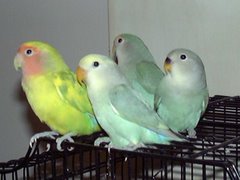Why do lovebirds pull out there feathers?
f you do perform lovebirds care really, you should know why do lovebirds pull out there feathers. Pulling feathers, one by one, and watching them float to the bottom of the cage can be fun to do if there is nothing. The reasons for feather plucking varies from maturity, abuse and neglect, dietary deficiency, boredom or lack of stimulus, changes or emotional upset, over grooming by mate, habit or medical problems (fungal or mold growths).
Lovebirds are playful by nature and it loves to follow you around on your shoulder. So it your duty to take care of your lovebirds perfectly. The most possible remedy to correct this anomaly is to determine the cause for feather plucking. The best way to prevent feather-plucking and to keep those beautiful feathers on your bird, is to provide your pet with plenty of exercise, entertainment and companionship. If it is a habit, it is mandatory to provide a mate to over coming this behavior. If it is due to hormonal change, which will be usually noticed during maturity. If the skin plucking is progressive and the skin started showing open pores, this is the high time to seek an appointment form your avian vet.









 Free Ads For Bloggers
Free Ads For Bloggers

